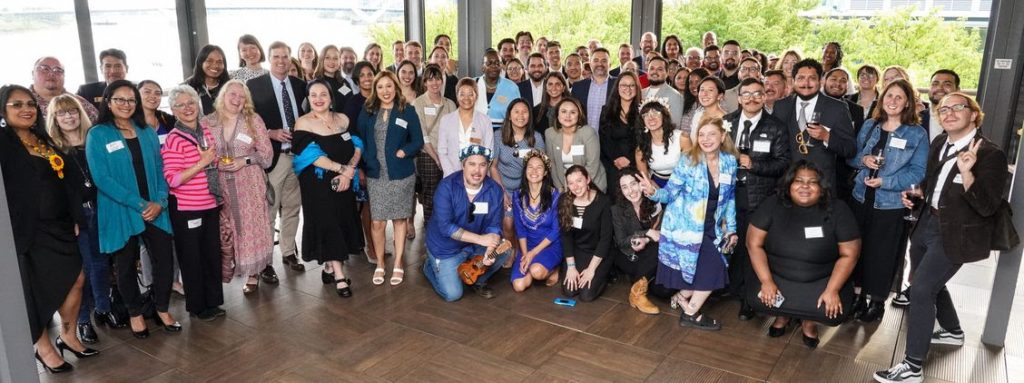ATB4ALL BLOG
Join us in learning about and celebrating the leaders and communities
on the frontlines of climate change that are working to protect 30×30, with a
Justice40 lens, through the America the Beautiful for All Coalition
Biden makes series of monuments and conservation announcements
By America the Beautiful for All
Posted: Monday, December 16, 2024, by Comms Team
President Biden is making a series of announcements in his closing days in office. The most recent were the creation of a monument for the nation’s first woman cabinet secretary, creation of a wildlife refuge in southern Maryland, final designation of a new national marine sanctuary, and a monument protecting the site of the Carlisle School, a federal Indian Boarding School that stole children from parents and moved them in an effort to erase their culture, tradition and language.
On December 16th, President Biden announced he will create a national monument remembering FDR-era Labor Secretary Frances Perkins, the first woman appointed to ever take a Cabinet position. She is credited with driving forward Roosevelt’s progressive New Deal social policies such as Social Security and the Fair Labor Standards Act. The monument will be established in Newcastle, Maine. Interpretation at the site, thanks to successful advocacy efforts, will tell her full story, including the troubling lack of awareness about the adverse impacts of racism on Black Americans.
Tribes and Native Americans push for awareness of “Boarding Schools.” The prior week, Biden established a national monument at the site of the former Carlisle Indian Industrial School in Pennsylvania and marked an important step in remembering the actions that forced assimilation, led to the deaths and abuse of hundreds of native children, and had cascading impacts of generational trauma on Native American, Alaska Native and Native Hawaiian people. Forced Indian Boarding Schools persisted for more than a century and a half through the 1960s. This monument helps ensure we do not forget.
Earlier in the year, Biden formally apologized on behalf of the U.S. government for the policy of forced assimilation, calling it a “blot on American history.” The progress during this year is due to the interventions of native tribes working with the administration and Interior Department, and organized efforts such as the National Native American Boarding School Healing Coalition, which works on a national scale to bring greater awareness of this ugly and long chapter in American history.
Biden also designated the Chumash Heritage National Marine Sanctuary protecting coastal and ocean waters off the Central California Coast from offshore oil expansion and other threats. The sanctuary was nominated in 2015 by the Northern Chumash Tribal Council.
At the close of the week, six counties in the Washington-Baltimore metropolitan area celebrated Interior’s establishment of the Southern Maryland Woodlands National Wildlife Refuge. The refuge will ultimately conserve 40,000 acres of forest, wetland, and riparian areas to bolster crucial outdoor recreation opportunities for the more than 10 million residents nearby the refuge while stewarding habitat for endangered and threatened species. National Wildlife Refuges supported nearly 41,000 jobs in 2020; since then Secretary of Interior Deb Haaland have established six national wildlife refuges and expanded others, promoting a trifecta of economic output, outdoor access, and biodiversity in communities.
State-based initiative made the difference. Last spring, a dozen coalition leaders asked the U.S. Fish and Wildlife Service’s (USFWS) to establish the Southern Maryland Woodlands National Wildlife Refuge as described in the Draft Environmental Assessment and Land Protection Plan (Draft EA/LPP) saying a draft land protection plan aligned closely with goals of the America the Beautiful for All initiative, which promotes the conservation of 30% of the Nation’s lands and waters by 2030. In fact, the state of Maryland has a Maryland the Beautiful Act passed in 2023 which sets an even higher bar for conservation with a goal of conserving 40% of its lands by 2040.
The Maryland law is emblematic of state initiatives that can advance progress over the next 4 years, as the federal government is expected to shift its focus away from urgent conservation efforts that will slow the impacts of nature loss.
Importantly, the draft plan incorporated elements of a federal executive order that would prioritize environmental justice for communities of color and low income populations, which have historically borne the brunt of pollution and other environmental harms. The population in the six counties in Maryland that will adjoin the refuge stands at 62.6 percent, well in excess of a 50 percent threshold laid out in the executive order.
Among the many benefits of the new refuge, hundreds of types of fish and wildlife including threatened species like sturgeon will be protected, and the 40,000 acres will help make the region more resilient to storm, floods and other problems that are being exacerbated by climate change. The protected area will also provide wildlife a greater area of connected landscapes to thrive as climate change continues to harm and degrade habitats.
Politics may change but our principles and vision do not
Our commitment to the community
2024 Election Statement
By America the Beautiful for All
Posted: Friday, November 8, 2024, by Comms Team
To Our Friends,
Many of us are grappling with the extensive implications of Tuesday’s election results and what they mean for our communities and the communities we serve. Campaign promises made by President-elect Trump have many of us fearing threats of retribution and violence and deep infringements on individual and community rights. Though we approach a very different federal policy landscape, our north star has not changed. The work for safe, healthy, and equitable benefits of nature for the communities who have long been denied their rightful seat at the table remains.
In the coming days and months, it will become more clear what we are facing in the next four years. But whatever emerges, we promise you this: we will face it together, linked arm in arm. The last two years have shown our strength in unity. Do not forget that we are the largest, most diverse conservation coalition of its kind ever created. We have made plans for this moment. Now is the time to galvanize our connections to one another because every single one of us is going to play a role in what happens next.
We are resolute in our commitment to stemming nature loss and fighting climate change, and to standing up for democracy and the frontline communities whose rights, health and freedoms are on the line. To our fellow communities of color, LGBTQIA2S+ communities, and the women who are justifiably fearful this week, this coalition stands with you in solidarity and in united power.
We will continue to lift up science, knowledge, culture, and tradition. We will use all of the tools at our disposal to continue to fight for justice at all levels of decision making for clean air, healthy land, and safe water. It is no coincidence that the communities facing voter suppression, xenophobia, racism, and underinvestment are the same communities who face nature loss, public health crises, pollution and exploitation by extractive industry. That was true before this election and it remains true today. We must continue our work, defend the wins we have secured to date, and show that durable conservation is the kind that celebrates and honors community, culture, tradition, dignity, and the American dream.
In this new chapter, we will be rigid in our values but flexible in approach. We will press forward in pursuit of 30×30 and Justice40. Without realizing these goals, the communities we are from and serve are at risk. Change is before us. But, members of our broad community stand ready to hold local governments, and state and federal agencies accountable to safe, healthy, and self-determined communities in every corner of the nation.
We will organize, we will unite, and we will make strides toward our common goals together. We will not waiver in our belief that the conservation movement must meaningfully represent communities across the nation and prioritize those who have been deliberately excluded or harmed by its choices. The work seems daunting but it is ours to do because if not us, then who?
We will take this one step at a time together. We encourage you to get out in nature this weekend, spend time with loved ones, and do things that make you happy, content, and rested. This movement needs you for what happens next.
Please join us on Tuesday, November 12th to kick off this new chapter. We will process the election, make space to discuss community needs, and take one collective step forward towards a conservation movement that looks like, sounds like, and serves everyone who calls America home.
Yours,
Mark & Nse on behalf of the coalition steering committee
Puerto Rico Conference Galvanizes a New Era of Conservation Leaders
By America the Beautiful for All
Posted: Wednesday, October 29, 2024, by Comms Team
The membership of the America the Beautiful for All coalition stretches from the Marianas to Maine, Alaska to Puerto Rico and the Virgin Islands. We are the largest, most diverse coalition of its kind to ever exist in the United States.
In October, the America the Beautiful For All Coalition held its inaugural conference, New Era, New Leaders: 5 Years to 30×30, in San Juan, Puerto Rico. Changemakers representing a diverse array of conservation justice issues, geographies and identities gathered to address nature loss which disproportionately harms communities of color and frontline communities. With only five years left to achieve the national and global initiative to conserve 30% of land and water by 2030, the conference aimed to forge an ethical and inclusive path forward, ensuring that the conservation movement truly reflects the diverse communities across the United States and territories. More than 175 participants from Alaska, Puerto Rico, Texas, and beyond attended.

Day 1: Ceremony, Inspiration and Celebration
The conference started off with a celebration of Puerto Rico’s Indigenous heritage, an areíto ceremony, led by a bohique (spiritual leader). The ceremony honored Taíno culture and relationship with Earth mother and invoked blessings from Yocahú, the supreme creator. It featured rhythmic sounds of traditional instruments, culminating in a symbolic gesture of commitment to environmental stewardship through dance and music. Coalition co-chairs, Mark Magaña, Founding President & CEO of GreenLatinos and Nsedu Obot Witherspoon, Executive Director, Children’s Environmental Health Network then reflected on the incredible progress made through coalition collective action and community care before panel discussions kicked off.
Inspiring panel discussions began with Raimundo Espinoza, Executive Director, Conservación ConCiencia, Robert Viqueira Ríos, Executive Director, Proyectores de Cuencas, Inc., Cynthia Lopez Burgos, Founder, La Maraña, Carmen Portela, Executive Director, Fundación Amigos de El Yunque, Inc & Dulce del Rio-Pineda, Founder, Mujeres de Islas on conservation and justice in Puerto Rico and the importance of representation of U.S. Territories in our movement for an equitable conservation movement that benefits everyone.
Greg Masten, National Congress of American Indians Foundation, Theresa Sheldon, Tulalip Tribes Board of Director, Tribal Councilwoman Denise Harvey, Confederated Tribes of Grand Ronde Community of Oregon, Patrick Gonzales Rogers, Yale School of Environmental Justice, & Karen Linnell, Ahtna Intertribal Resource Commission/Copper River-Ahtna Inter-Tribal Resource Conservation District held an important panel on Tribal Sovereignty and Self-Determination: Advancing Indigenous-Led Conservation.
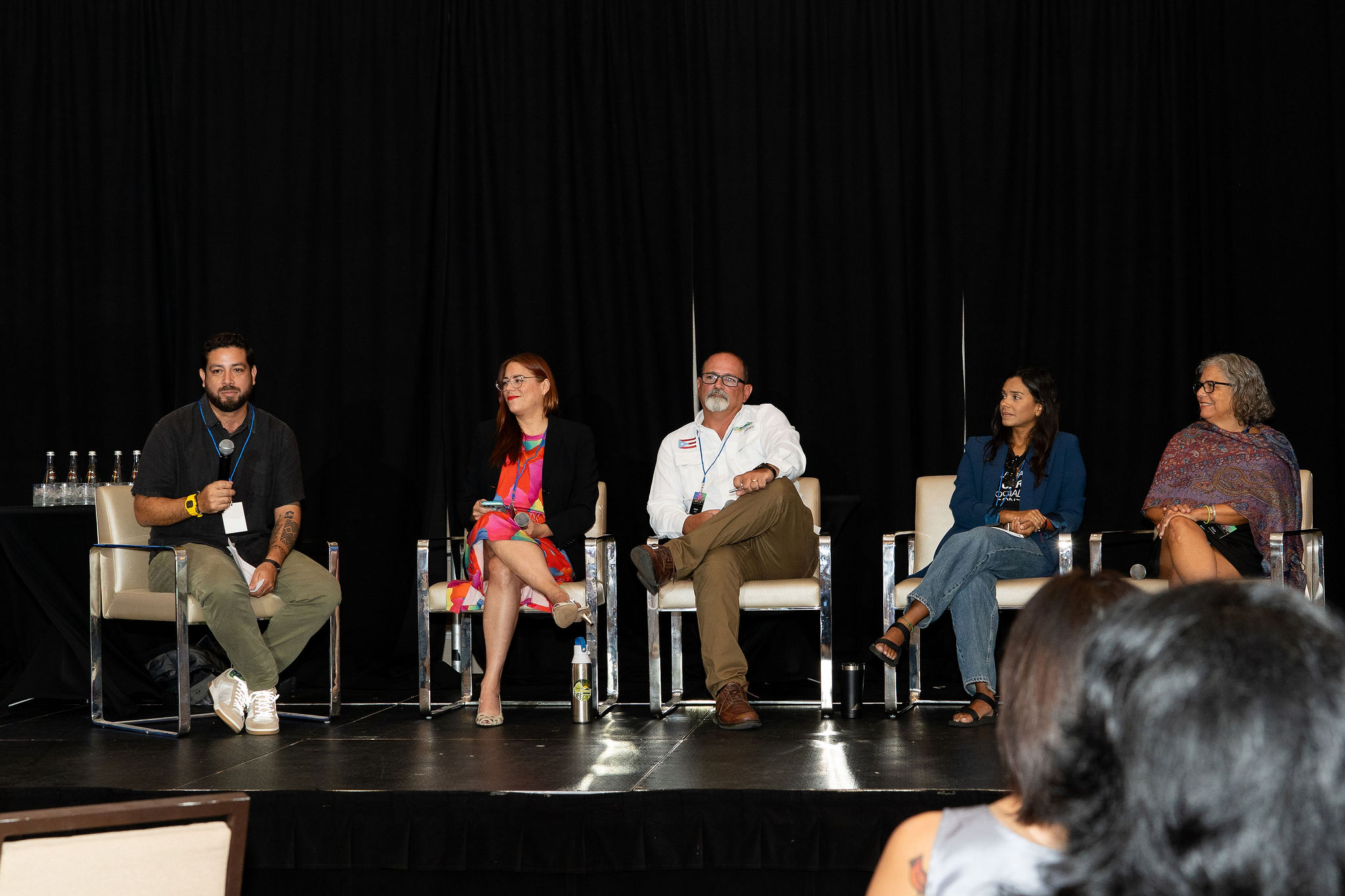
Vu Le brought a humorous perspective to the nonprofit sector’s struggles, in a talk about shifting the movement and decolonizing philanthropy. He explored tools for values-driven conservation in the face of challenging power dynamics. Then, numerous breakout sessions focused on equity-centered biodiversity conservation planning, legal empowerment of communities, equity in private land conservation, and effective conservation in ocean and coastal stewardship.
“We’ve become so professionalized as a sector; we can write our theories of change and other strategic plans. But we’ve lost our ability to get 100 people to city hall, or 500 people on the streets in protest.”
-Vu Le
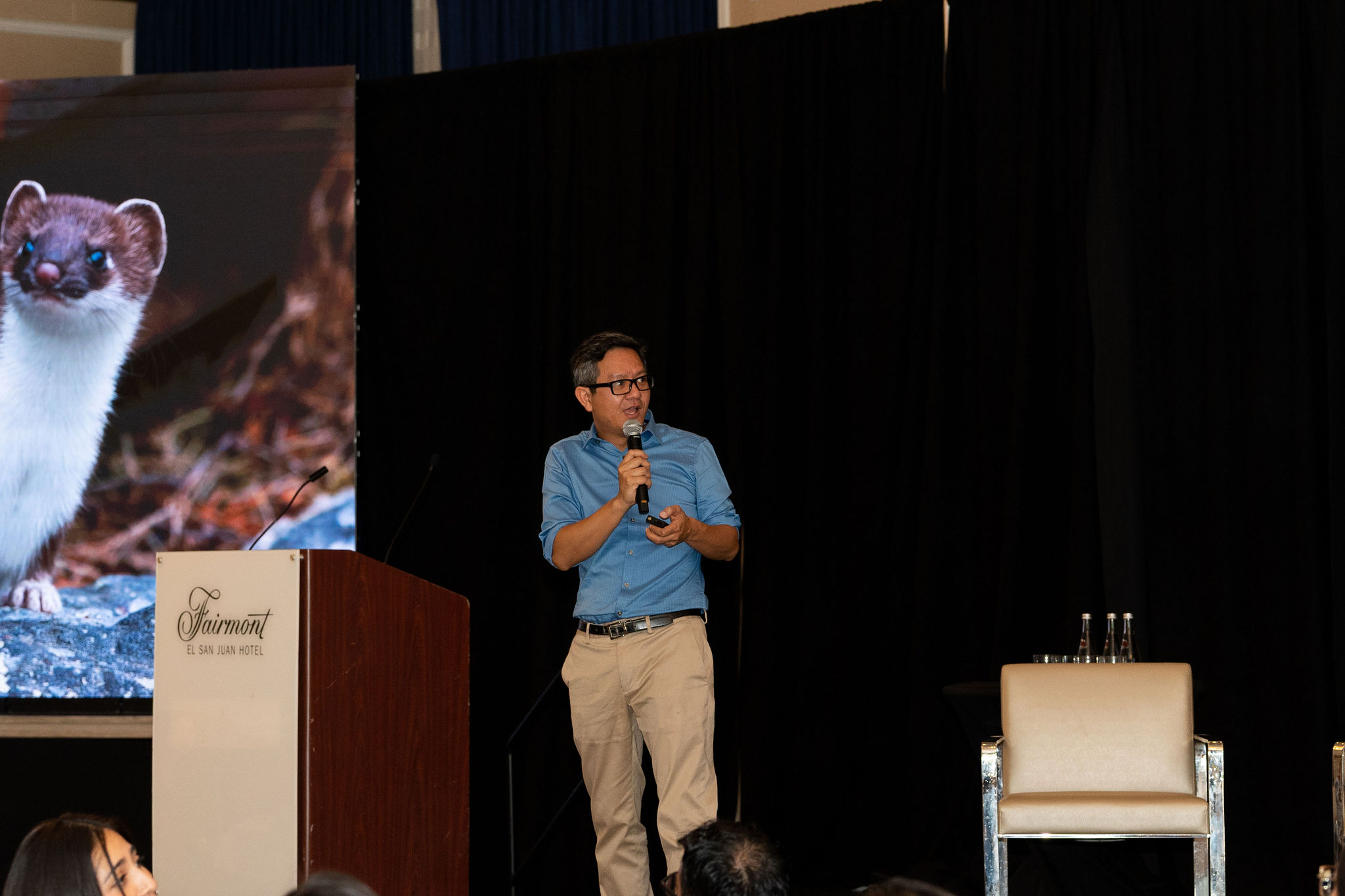
Conference breakout sessions:
- Equity-centric Biodiversity Conservation Planning
- Water, Rights, and Resilience: Empowering Communities Through Legal Innovation
- Reclaiming the Legacy: Forging Equity in Private Land Conservation,
- More than Acres: Ensuring Effective and Equitable Conservation Beyond 30×30 in Ocean and Coastal stewardship.
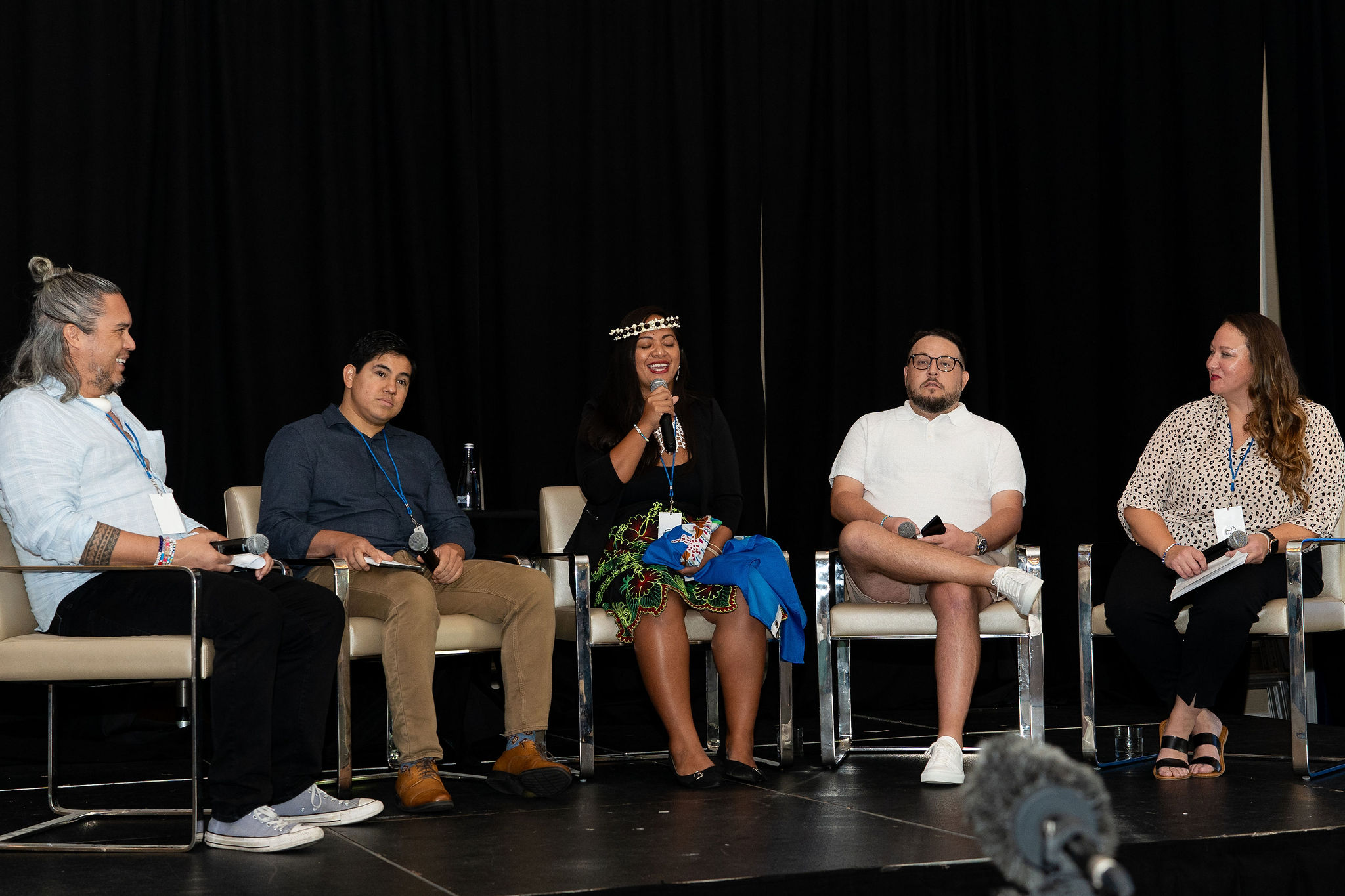
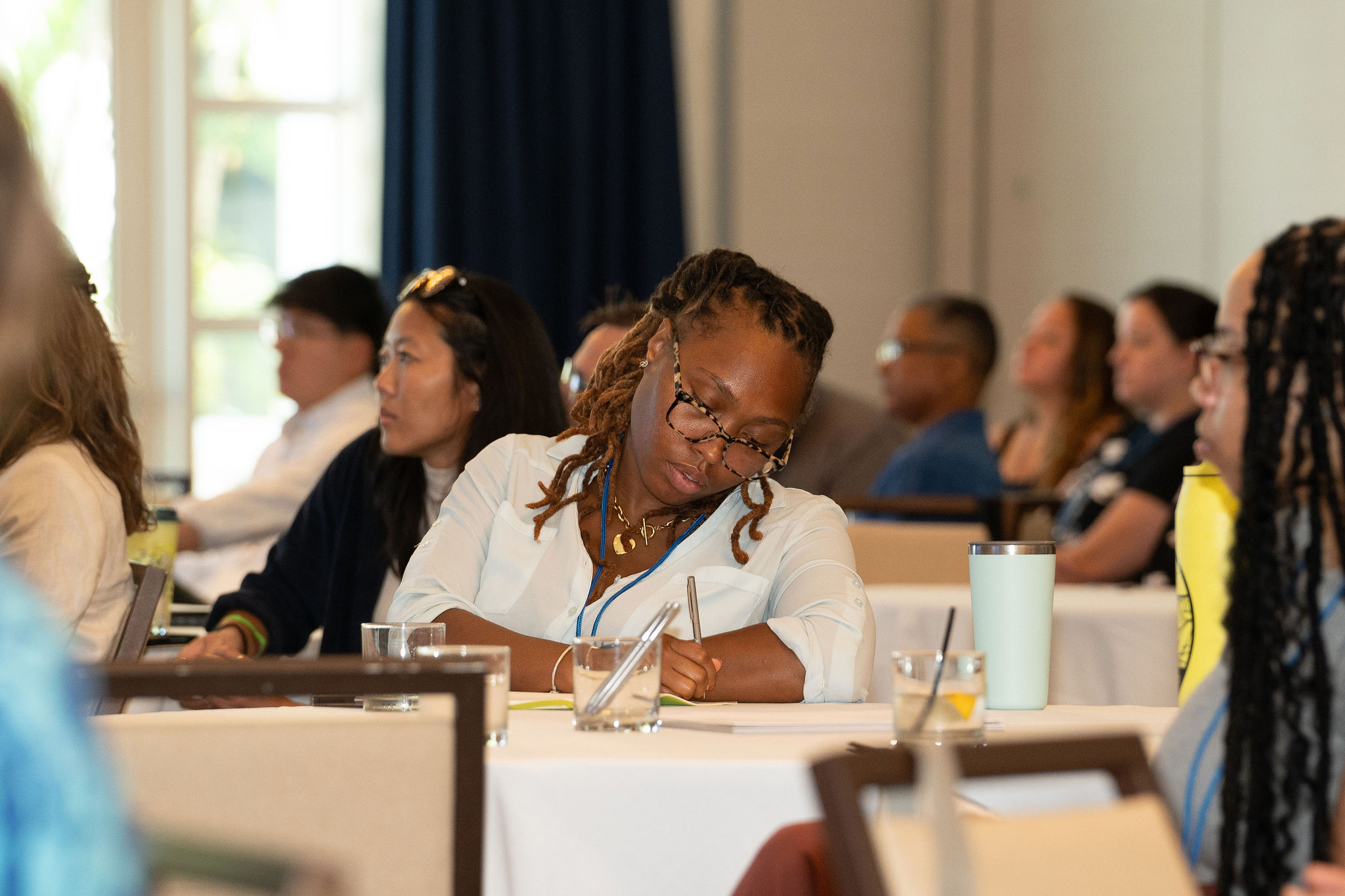
Following the breakout sessions, Angelo Villagomez, Senior Fellow, Center for American Progress, Jerry Otero, Legislative and Policy Director, Grand Canyon Trust, Starlyn Miller, Little Shell Chippewa, Adrian Angulo, Campaigns & Programs Director, Nuestra Tierra Conservation Project & Sheila Babauta, Friends of the Marianas Trench conducted a dynamic panel on practical tools and strategies for implementing justice-oriented, 21st century conservation initiatives.
Coalition members, Kai Tran, Jen Felt, Nicole Yanes, and Michelle Schärer-Umpierre, led community speed talks during breakfast every day, where they updated conference participants on efforts toward achieving our twin goals for 30×30 and Justice40.
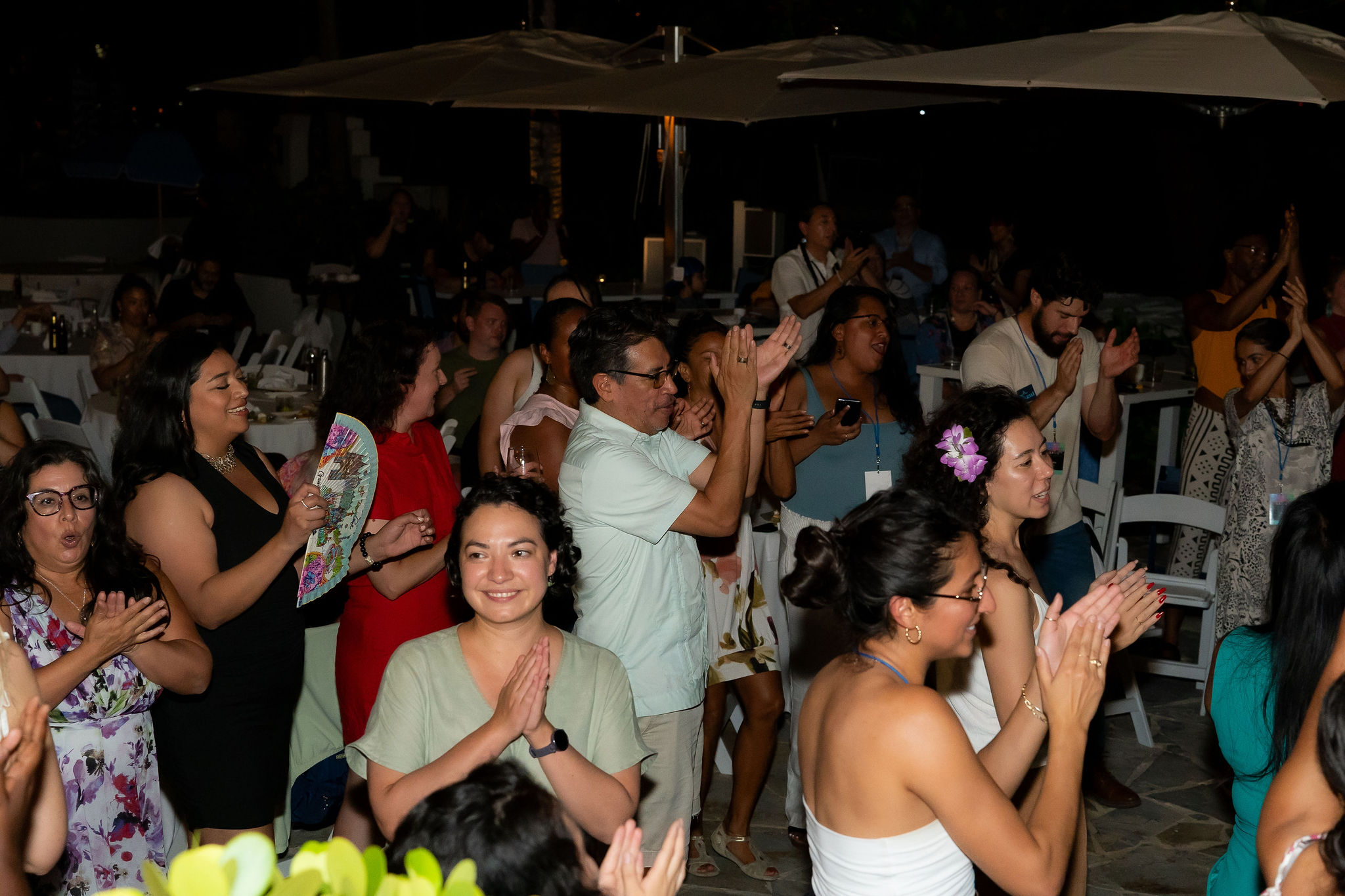
The day concluded with a community dinner, dance party and awards for outstanding changemakers at the forefront of furthering ATB4All Coalition twin goals.
2024 Awardees
- Amy Cordalis – Transformative Leadership Award
- April Monroe – Courageous Leadership Award
- Richard Juang – Community Commitment Award
- Corina Newsome – Trailblazer Award for Equity in Wildlife Science
- Kai Tran – Emerging Leader Award
- Julian Gonzalez – Clean Water & Community Award
Day 2: Music, Leadership and Nature
Kevin Chang, Executive Director, Kua’aina Ulu ‘Auamo & Kate Burgess, Conservation Program Manager, National Caucus of Environmental Legislators kicked off the morning by performing two songs and leading a community grounding exercise.
White House Council on Environmental Quality Chair Brenda Mallory delivered a keynote address on the Biden Administration’s Justice40 and conservation progress. It was followed by a panel on the importance of social and environmental health in conservation by Nathaniel Smith, Founder, Chief Equity Officer, Partnership for Southern Equity, Nsedu Obot Witherspoon, Executive Director, Children’s Environmental Health Network, Joel Pannell, Vice President, Urban Forests Policy, American Forests, Daniel Smith, Board Member, Alliance of Nurses for Healthy Environments, and Adrienne Hollis, Vice President for Environmental Justice, Health and Community Revitalization, National Wildlife Federation.
“Privilege is only powerful if you are willing to share it.”
-Nathaniel Smith

The afternoon concluded with a discussion on Project 2025, how it targets our shared issues and new ambition for the last half of accomplishing 30×30 in a potential Harris-Walz Administration. This panel featured Jerry Otero, Legislative and Policy Director, Grand Canyon Trust, Will Fadely, Vice President, Cassidy & Associates, B. ‘Toastie’ Oaster, Award Winning Journalist, High Country News, and Addie Haughey, Legislative Director, Lands, Wildlife, and Oceans Policy and Legislation Team, Earthjustice.

What is a trip to la isla del paraiso without quality time in nature? Following another round of unforgettable talks and delicious meals, conference attendees embarked on outings to El Yunque National Forest, Old San Juan, and a local mangrove.
Day 3: Collective Visioning, Narrative Power and Change
The final day of our inaugural conference started with a powerful storytelling panel on building authentic coalition power with B. ‘Toastie’ Oaster, Award Winning Journalist, High Country News, Gabaccia Moreno, Executive Director, The Outdoorist Oath, Amy Thompson, Million Person Project, Sean A. Watkins (they/them), Founder & Principal Storytelling Consultant, Agency of Joy, Rae Breaux, Just Transitions Partnerships Sr Manager, Center for Story Based Strategy & Diandra Esparza, Co-founder of Intersectional Environmentalist.
Then, conference attendees broke out into more than a dozen small groups to workshop top priorities for conservation justice in 2025 and beyond. This was a crucial moment for community collaboration as we prepare to successfully accomplish our shared goals in any and all government leadership scenarios.
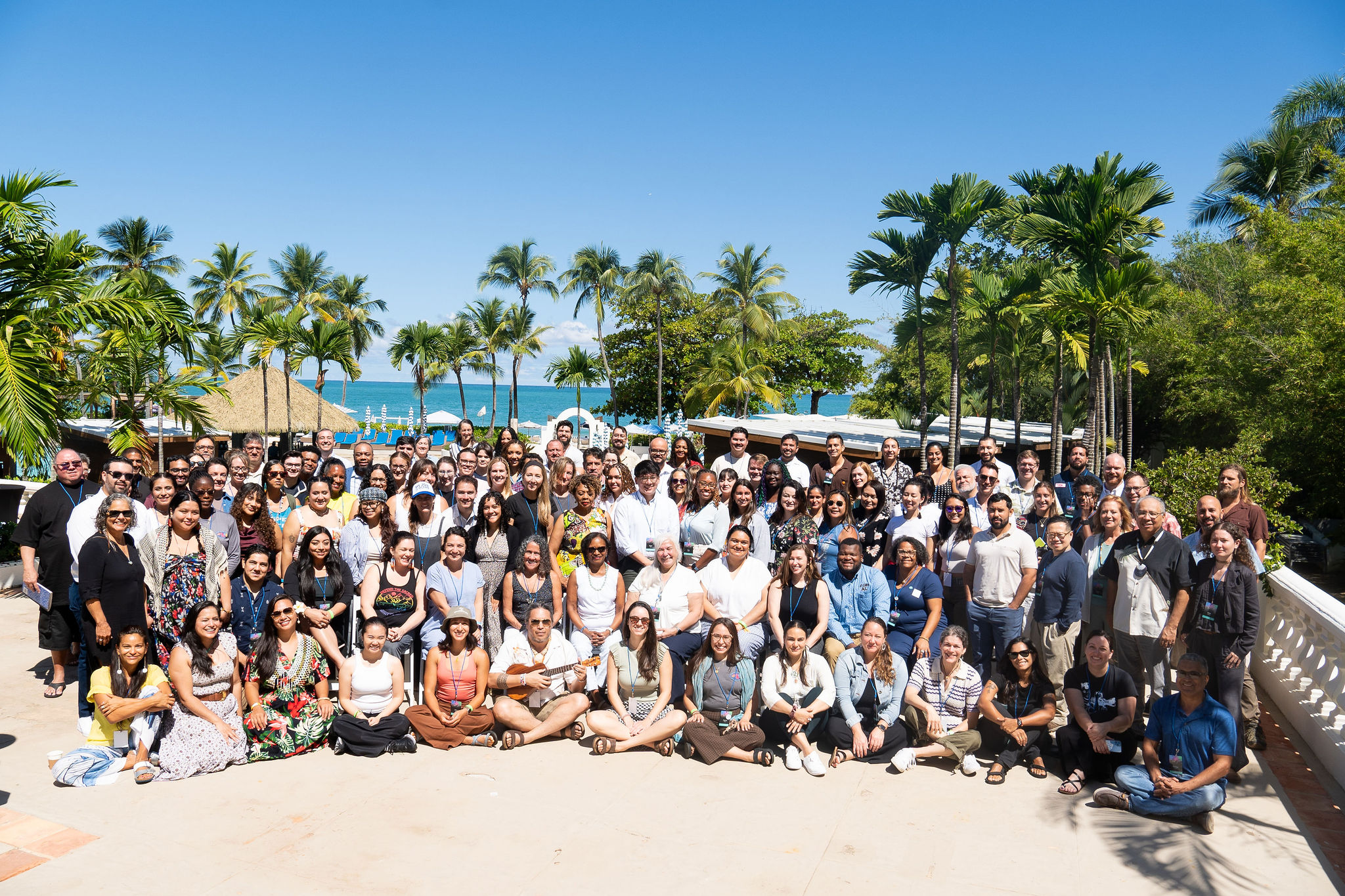
Thank you to all who contributed to the success of this bold and inspirational conference. Onwards to a visionary, daring, inclusive, accessible, safe, healthy and just new chapter.
6 Ways to Support the America the Beautiful for All Coalition
By America the Beautiful for All
Posted: Wednesday, October 16, 2024, by Comms Team
The membership of the America the Beautiful for All coalition stretches from the Marianas to Maine, Alaska to Puerto Rico and the Virgin Islands. We are the largest, most diverse coalition of its kind to ever exist in the United States.
Last week, 170+ conservation, climate change, and community leaders from across the United States spent three busy days in San Juan, Puerto Rico at our coalition’s New Era, New Leaders conference.
This conference was not your usual conservation conference. I moderated a panel called, “Tools to facilitate values-first conservation when power dynamics make it hard” and we talked about some of the things that make it difficult for people of color to get into and stay in the conservation movement. We shared stories and strategies on how to build community and to organize to uplift our ideas and power.
Our coalition is growing, and you are invited to be a part of it. It can be intimidating for newcomers to figure out the best way to plug in, so here are a 6 ideas for new coalition members, or potential new members, to get involved with our coalition in support of creating a more just and equitable conservation movement:
- Join the Coalition email list. The simplest way to participate in our coalition, and the one that requires the least effort, is to navigate to the America the Beautiful for All coalition website, scroll to the bottom, type your email address, and click subscribe. We send out a monthly newsletter with links to actions you can take in support of our coalition partners’ efforts, conservation news and updates, as well as upcoming events.
- Join and Share Our Social Media. The America the Beautiful for All Coalition is on Facebook, Instagram, Twitter (also known as X) and LinkedIn. Please follow our accounts and share our posts when you see them. We also have 250+ partner organizations and we encourage you to follow and share them, too!
- Join a workgroup. Our coalition has six issue-based workgroups (Urban Parks & Greenspace, Ocean, Wildlife, Public Lands, Freshwater, and Legacy Lands) and one cross-cutting workgroup called Priorities, Projects, & Campaigns. Each of the workgroups has two co-leads who coordinate our coalition partners’ activities. The management of each is somewhat decentralized from the full coalition, and the best way to learn about each issue is to reach out to the co-leads (click on their bios on the website) to request more information. The different workgroups use different tools to communicate with one another, including google groups, Whatsapp, email, and regular meetings. Each co-lead can recommend the best way for you or your organization to participate.
- Endorse our policy agenda. As I write this, we are about 4 weeks away from Election Day in the United States and regardless of the outcome, there will be a new president on January 20, 2025. In 2023 and in 2024 our coalition put forward policy agendas to outline our conservation priorities for the Biden administration. We plan to do the same for the next president. During our conference in Puerto Rico last week, all of the participants had the opportunity to share those ideas and we will be collecting them and sharing them regardless of the election outcome. If you join our coalition email list, in the coming weeks and months we will share how your organization can help set the tone for the next administration’s conservation efforts.
- Come to Our Events. The New Era, New Leaders conference was the culmination of two years of organizing and relationship building across our movement. Along the way we held two Washington, DC fly-ins, where advocates from across the country walked through the halls of power to call on the Biden administration and US Congress to take just and equitable actions to protect nature and people. During the fly-ins, our coalition partners helped tell these stories, which include Tina Sablan from the Northern Mariana Islands successfully advocating for a Mariana Trench monument management plan and Tess Hostetter calling for the protection of Alaska’s D-1 lands. Throughout the course of the year we also held smaller events across the country to organize, advocate, and learn from one another.
- Donate to support our coalition partners. We have over 250 coalition members working across many facets of conservation in our country. We encourage you to support them and their participation in our coalition. You can also support the management and coordination of the coalition by reaching out to our development team. For example, you can support travel for our members to advocate for their issues in Washington, DC, or to send them to training and capacity building workshops.
The direction our coalition takes in the next few years will be determined in the next few weeks. It’s not yet clear if we will spend the next four years fighting off all the terrible ideas found in Project 2025 or if we will be looking to build on the conservation success of the Biden administration. Regardless of the outcome, our coalition is committed to growing a conservation movement that reflects the diversity and experiences of America, and we invite you to be a part of that.
Springfield Race Riots National Monument Helps Tell the Full American Story
Monument joins Blackwell School, Avi Kwa Ame and Castner Range designations made by Biden-Harris administration, hopefully with more to come
By America the Beautiful for All
Posted: Friday, August 16 2024, by Comms Team
Following the Blackwell School National Historic Site in Texas becoming the nation’s 430th national park in July, the Biden-Harris administration is going a step further towards a public land system that reflects all Americans. On August 16, 2024, President Biden established the 1908 Springfield Race Riot National Monument after several years of pressure from community leaders urging him to conserve the historic site under the authority of the Antiquities Act. This new monument would for the first time acknowledge this dark chapter in U.S. history on public lands, honor the legacy of civic rights leader Ida B. Wells and the formation of the NAACP, and allow the nation to learn from this history. The move has been supported by a bipartisan group of members of Congress and drew accolades from a broad coalition of groups urging the president to make the move, ranging from Black Lives Matter, to the National Religious Partnership for the Environment, to Sierra Club, to the Lincoln Presidential Foundation among others.
The designation permanently memorializes the site of the August 14, 1908, attack by a white mob who lynched Black residents of Springfield, Illinois, while setting fire to their homes and businesses. The aggression was so heinous, it would become the impetus for the founding of the National Association for the Advancement of Colored People (NAACP), the leading national voice for equity and justice for Black people and other people of color for more than a century.
“We must remember, resolve and restore. The 1908 Springfield Race Riot should live in our hearts and minds forever as a constant reminder of man’s capacity for cruelty and inhumanity against his fellow man,” said Austin Randolph, president of the Springfield NAACP branch. “Make no mistake, there is a whole lot more work to do. Within the struggle in our hearts and minds, lies the desire for equity, peace and healing. This national monument will forever stand for freedom and justice. It will be our solemn reminder of where we came from as it propels us towards where we are destined to be: equal.”
Underscoring that systemic injustice and racial violence remain a scourge and that we must tell the stories of those whose lives are lost and forever changed as a result, the decision happens just five weeks after the shooting of Sonya Massey in her own home in Springfield, after she called police fearing an intruder in her home. A white officer on the scene shot her in the face, killing the 36 year old unarmed Black woman. The America the Beautiful for All Coalition (ATB4A) stands with communities impacted by racial violence and solemnly celebrates the Biden-Harris Administration’s designation that preserves the story of the 1908 Springfield Race Riot. Commemorating hard truths and ensuring they are not lost to history is a critical ingredient to ensuring we are not destined to repeat history. In Springfield, IL, the community deserves to have the stories they have long fought to preserve protected in perpetuity. Telling more of the nation’s story through America’s public lands is a legacy the Biden-Harris Administration should continue.
A legacy of protecting historic cultural sites
The move comes just weeks after the administration named the site of the Blackwell School in Marfa, Texas, as its newest national park. The Blackwell School was built in 1909 and segregated Mexican American children from their white peers, and violently punished students for speaking Spanish. In addition to the main adobe structure, the protected site included an on-site annex built in 1927.
“President Biden ran for president promising to conserve more lands and cultural sites while fighting for environmental justice for communities of color, and he is delivering,” said Angel Peña, executive director of the Nuestra Tierra Conservation Project. “No administration has done more in modern history to protect public lands, waters and cultural sites.”
The Biden-Harris administration’s land and water conservation initiatives have drawn praise from the coalition, which is urging the protection of 30 percent of U.S. land and waters by 2030 that prioritizes communities on the frontlines of the climate and nature loss crisis. These efforts are vital to addressing the climate crisis, protecting the health of communities, while promoting wildlife and biological diversity. Securing a future with abundant access to nature and healthy public spaces that are welcoming to all communities starts with ensuring our public lands represent all of us.
Since the launch of the administration’s America the Beautiful initiative, the U.S. has experienced one of the most rapid accelerations of conservation progress in the nation’s history, with more than 41 million acres of land and water conserved in three years. This important surge in protections has been stimulated by local frontline communities who address public health challenges by preserving places of cultural, ecological, and historic significance for the benefit of everyone.
According to Colorado College’s 2024 “State of the Rockies” poll, voters in every state polled show overwhelming support for the nation’s most ambitious conservation goal in history. “Eight-in-ten (80 percent) support conserving 30 percent of land and inland waters in America, and 30 percent of its ocean areas by 2030, with overwhelming support across party lines.” Sixty-eight percent of Republicans, 83 percent of Independents, and 91 percent of Democrats support the 30 by 30 conservation proposal, Colorado College reports.
Prioritizing Indigenous and Tribal cultural sites
Since U.S. Secretary of Interior Deb Haaland–a Pueblo of Laguna member and the first Native American cabinet member in U.S. history–has taken office, the Department of Interior Secretary and President Biden delivered on two key national monument decisions among others that honored decades of community-led efforts to preserve significant cultural sites. Last year, President Biden and Secretary Haaland created the Avi Kwa Ame National Monument in Nevada and Castner Range National Monument in Texas.
The Castner Range monument is under the control of the U.S. Army, who were asked by the White House to work with tribes and the El Paso community to ensure public access. The Army used the desert at Castner Range as a training site between 1926 and 1966, and the site continues to be strewn with untriggered munitions.The first all-Black regiments of U.S. Army units, known as Buffalo Soldiers, were installed on this Department of Defense-administered landscape.
The space was also formerly home to multiple Native American tribes including the Apache and Pueblo peoples, the Comanche Nation, the Hopi Tribe, and the Kiowa Indian Tribe of Oklahoma.
President Biden and Secretary Haaland’s establishment of Avi Kwa Ame National Monument protected 500,000 acres of land in Nevada considered sacred to Native tribes. Known as the “center of creation” by Yuman-speaking Tribes, and sacred to other Indigenous peoples, Avi Kwa Ame means “Spirit Mountain” in the Mojave language. These critical ecological hotspots form a connective tissue for migrating wildlife where ancestral petroglyphs will remain in perpetuity.
Both monuments were designated using the 1906 Antiquities Act which allows the President to protect landmarks, structures and federal lands for cultural and ecological conservation. The administration’s actions will prevent private development on the lands and ensure that the federal government works with Native Americans to protect these places for generations.
The truths at the intersection of land and history
In moving forward with this monument designation, the Biden-Harris administration furthers efforts made by communities, Tribes and governments at all levels to have America’s public lands reflect a more complete American story, where people of differing races, cultures and religions see themselves reflected in their public lands.
The coalition believes monuments such as this can teach hard and painful lessons, but also create a more honest and complete interpretation of our public lands and waters.
In instances like Springfield, they are sobering reminders of systemic injustice that reverberates in communities today. There are also many chapters of triumph, brilliance, and achievement that have not been told, especially critical stories from communities of color left to the margins. These stories must be preserved and told through our public lands.
A report from the National Religious Partnership for the Environment found that only about 180 of the 2,600 historical landmarks in the country are considered African American historical landmarks. And of the 129 national monuments designated by U.S. presidents since 1906, 12 represent the history and stories of Black people.
The America the Beautiful for All Coalition, comprised of more than 250 member organizations from across the nation and a variety of missions, calls on the Biden Administration to cement their legacy of preserving special places and lifting up the history of communities of color and Indigenous people in our public lands. There is more work to be done and the coalition stands ready to support local communities and the Biden administration to preserve these stories through our public lands.
The America the Beautiful for All Coalition is the largest and most representative national coalition consisting of more than 250 organizations working collectively to advance the national goal to protect 30% of US land, water and ocean by 2030 (30×30) and apply a Justice40 metric to that goal. These goals comprise national plans to thwart destruction of natural climate solutions; stem the loss of biodiversity; increase equitable access to nature’s benefits. Working across a range of missions, identities, communities and cultures, this coalition is leveraging the national 30×30 goal to write a new chapter of the American conservation movement where its leaders are more representative of the communities on the frontlines of these crises and where collective action leverages a range of lived and learned experience to drive community-based solutions into DC policy-making. www.americathebeautifulforall.org
America the Beautiful for All supports the designation of the Santa Cruz River Urban National Wildlife Refuge
By America the Beautiful for All
Posted: Tuesday, July 2, 2024, by Comms Team
The America the Beautiful for All Coalition Wildlife Workgroup expresses support for the Santa Cruz River Urban National Wildlife Refuge designation in southern Arizona. The establishment of this urban national wildlife refuge would meaningfully contribute to the administration’s America the Beautiful initiative and be a historic example of a locally-led, community-driven conservation and restoration of a culturally and ecologically significant landscape.
The vision for the Santa Cruz River Urban National Wildlife Refuge involves an archipelago of protected properties along the Santa Cruz River that would offer permanent wildlife habitat, outdoor access, and ecotourism. The land in the urban core would anchor this “string of pearls,” offering shade, river access, and outdoor education for the neighboring communities. The Santa Cruz River corridor offers abundant recreation opportunities, including birdwatching at Sweetwater Wetlands, and cycling and walking along the award-winning 137-mile Chuck Huckelberry Loop, a beloved paved recreation trail with dozens of access points that runs alongside the Santa Cruz River and its major tributaries.
Local leaders, alongside restoration volunteers, have created over 17 miles of vibrant habitat that has been foundational to the recovery of native vegetation, wildlife, insects, reptiles, fish and migratory birds. Collaborations between governments, academics, non- profits and volunteers have helped establish the importance of the river corridor for wildlife and connectivity to the surrounding Sky Island mountain ranges. The people of the San Xavier District of the Tohono O’odham Nation have ancestral ties to the flowing Santa Cruz River and the lands around it. The original homeland of the Tohono O’odham Nation is located near what is now downtown Tucson on the river, which the people of the Nation have stewarded for millennia. They continue to access these lands for ongoing cultural and religious practices.
The America the Beautiful for All Coalition Wildlife Workgroup requests the U.S. Fish and Wildlife Service designate the country’s newest urban national wildlife refuge, the Santa Cruz River Urban National Wildlife Refuge, along the length of the Santa Cruz, south and north of the San Xavier District, in Santa Cruz and Pima Counties to preserve the river’s past, present and future.
“Designation of the Santa Cruz River Urban National Wildlife Refuge would be a celebrated win for community-led conservation efforts. A new national wildlife refuge would protect important habitat for the endangered Southwestern willow flycatcher and hundreds more animals, all while ensuring access for Tucson residents and visitors to connect with nature and cherished wildlife.” – Jewel Tomasula, Policy Advisory at Endangered Species Coalition.
“The Santa Cruz River Urban National Wildlife Refuge is a critical step towards ensuring that everyone, regardless of background, has the opportunity to experience and benefit from the beauty and biodiversity of our natural world. Access to urban green spaces and wildlife sanctuaries is essential for the well-being of marginalized communities. These areas provide critical opportunities for recreation, education, and a connection to nature that enriches our lives and cultural heritage. This refuge will not only protect vital habitats but also foster a sense of stewardship and belonging.” — Adrian Angulo, Campaign and Program Director at Nuestra Tierra Conservation Project.

Earth Month 2024 Recap: Biden Adminstration Makes Monumental Conservation Progress
By America the Beautiful for All
Posted: Monday, May 13, 2024, by Comms Team
The Biden Administration announced a series of policy changes that set a course for a more sustainable future. With the Conservation and Landscape Health Rule and new actions to protect land in the Alaskan Arctic, the administration took bold steps to protect public land. Additionally, the administration has announced new and ambitious goals for protecting freshwater resources, which are crucial to conserving 30% of the United States’ lands, freshwater, and oceans by 2030 while ensuring that at least 40% of the overall benefits flow into disadvantaged communities. The Biden-Harris administration has now protected more than 41 million acres of lands and waters—putting President Biden on track to conserve more lands and waters than any President in history.
The progress during Earth Month complements President Biden’s America the Beautiful initiative, a 10-year, locally-led and nationally-scaled effort to protect, conserve, and restore the lands, waters, and wildlife upon which we all depend. It also builds on President Biden’s Investing in America agenda, which outlines historic investments in public lands and waters.
The Conservation and Landscape Health Rule Protects America’s most iconic and vital public lands
The Department of the Interior announced the final Conservation and Landscape Health Rule, providing tools for the Bureau of Land Management (BLM) to protect public lands in the face of climate change, conserve important wildlife habitats, facilitate responsible development, and better recognize unique cultural and natural resources on public lands.
BLM lands represent nearly 40% of America’s public lands. They are home to culturally and ecologically significant places sacred to Tribes and many communities. The Conservation and Landscape Health Rule is a crucial step towards achieving conservation goals while preserving the culture and stories the lands represent to rural, frontline, and communities of color.
“We applaud the Biden administration’s decision to preserve cultural areas, better protect wildlife habitat, and safeguard outdoor access and recreational opportunities.”
– André Sanchez, Community Engagement and Conservation Policy Manager, CalWild
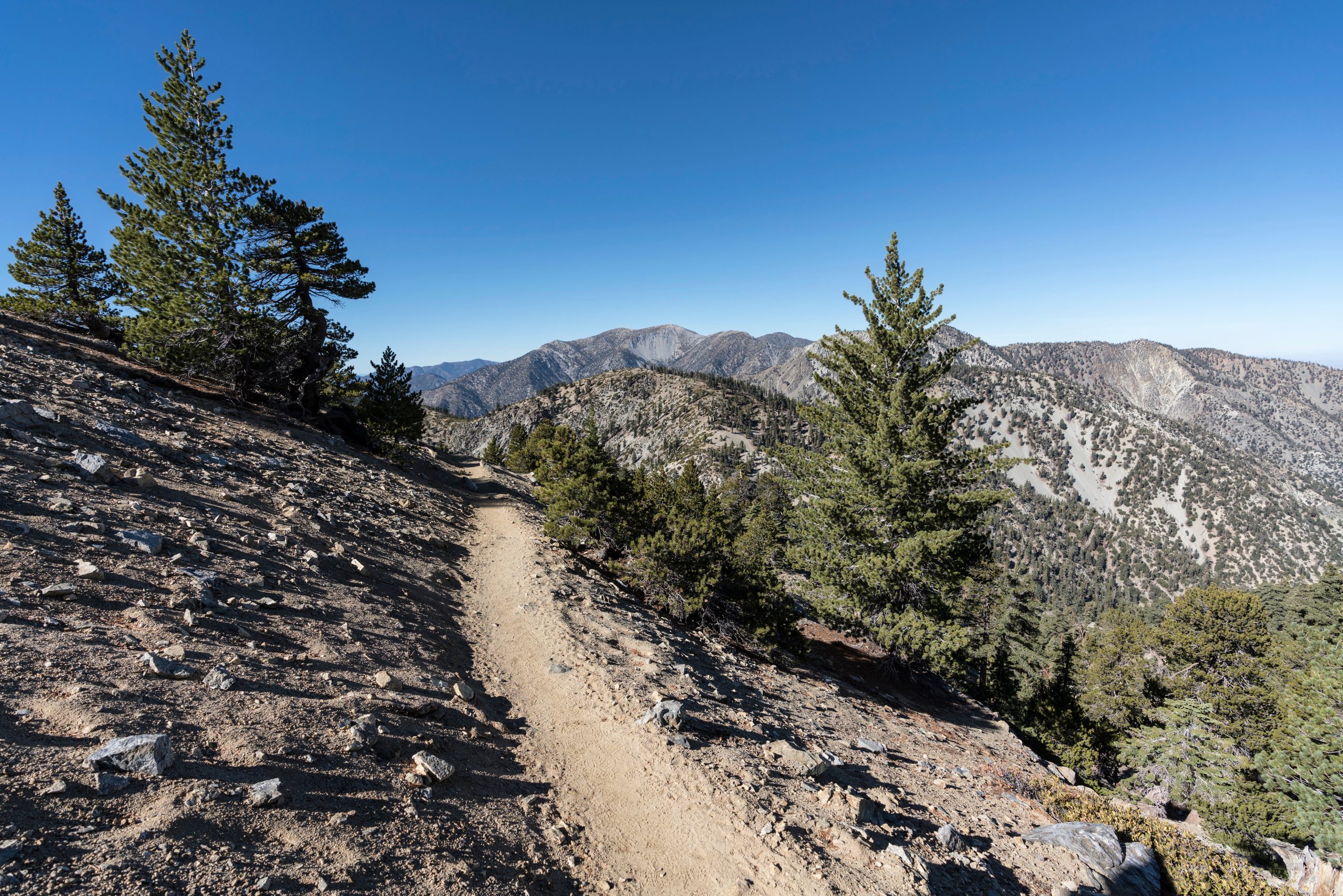
Two New Actions Make Critical Progress in Protecting the Alaskan Arctic
The Biden Administration took key actions to conserve Alaskan fish and wildlife habitats, reduce extractive activities on public lands, and ensure millions of acres of land are managed appropriately to protect the subsistence economy that is significant to Alaska Native people and rural communities. These steps follow President Biden’s actions in March to protect millions of acres of lands and waters in the Arctic, including approximately 2.8 million acres of the Beaufort Sea, ensuring the entire United States Arctic Ocean is off limits to new oil and gas leasing.
After significant engagement with the public, Alaska Native Tribes, and Alaska Native Corporations, the BLM finalized the Management and Protection of the National Petroleum Reserve in Alaska (NPR-A) rule, which will ensure maximum protection for 13 million acres land in the western Arctic, while supporting subsistence uses and needs for Alaska Native communities.
The BLM also released its environmental analysis for the Ambler Road project—a proposed plan to build a road that would span over 210 miles of significant wildlife habitat and pristine waters that are vital for subsistence along the iconic Brooks Range in north central Alaska. The BLM recommended that the road not be built, finding that any development would significantly and irrevocably impact resources, including those supporting important subsistence uses in ways that can not be mitigated.

Biden Administration Announces Bold Freshwater Protection Goals
As a part of its America the Beautiful Freshwater Challenge, the Biden Administration announced new national goals to protect rivers and freshwater resources. These goals — the most ambitious in United States history — include protecting and restoring 8 million acres of wetlands and 100,000 miles of rivers by 2030.
To achieve these goals and to ensure that our freshwater resources are protected for current and future generations, the Biden-Harris Administration is calling on all states, Tribes, interstate organizations, cities, and local communities, to advance their own policies and strategies for conserving and restoring America’s freshwater systems. More than 100 inaugural members have already signed on to support freshwater restoration including seven states, eight Tribes, and 24 local governments.
“As a member of the America the Beautiful for All Coalition, the Rio Grande International Study Center strongly endorses the Biden-Harris Administration’s America the Beautiful Freshwater Challenge. This initiative is a logical next step – a natural extension in our continued work to protect and restore the Rio Grande and a robust affirmation of our organization’s commitment to freshwater protection. We do so by leveraging and enhancing our reach in this united cause to promote our shared vision that our communities’ water resources are responsibly managed and protected for the benefit of generations to come.”
– Martin Castro, Watershed Science Director at Rio Grande International Study Center
April’s Progress Sets the Course for Continued Action
The Biden Administration demonstrated remarkable dedication to advancing conservation goals. Building off other key climate initiatives, this administration has undeniably charted new territory in conservation.
While celebrating these achievements, it’s crucial to acknowledge that the work to advance equitable conservation projects is ongoing. Ensuring that all communities benefit from and participate in conservation is essential for long-term success and impact. Conservation work must prioritize equity and consider the unique meaning of public land and waters for different cultural and identity groups across the country. The America the Beautiful for All Coalition looks forward to continuing to collaborate with the Biden Administration to work towards conservation goals that keep justice and equity at the top of mind.
Op-ed: Celebrating Collective Power for Change
through the America the Beautiful for All Coalition
By Justice Outside President and CEO Kim Moore Bailey
Posted: Tuesday, February 27, 2024, by Comms Team
Last year, I was approached to join the America the Beautiful for All steering committee alongside a stellar group of leaders and advocates in the environmental and outdoors sector. I accepted the opportunity not only because its mission spoke to me personally, but also because the Coalition’s twin goals—protecting 30% of our lands and waters by 2030 and ensuring that at least 40% of investments in reaching this historic goal are made in communities of color and frontline communities that have historically seen little to no investment in conservation and equitable access to nature—are the key to facing the deeply rooted inequities in our sector and mitigating some of the worst impacts of climate change.
The Coalition’s work and the process in which we are advancing change spoke to my experiences as a Black woman leader in the environmental and outdoors sector. Black, Indigenous, and Communities of Color often hold the solutions to the issues facing our world, from climate change to economic disparity. Through centuries of having to survive without consistent investment from the state, we have learned how to lean on each other and creatively find solutions that are rooted in mutual aid and community support. Yet, we’re severely underrepresented in the environmental and outdoor sector. That’s why my organization Justice Outside works to advance racial justice and equity in the outdoor and environmental sector through building organizational capacity, developing the outdoors workforce, grantmaking, and advocacy. We joined the America the Beautiful for All coalition because it is intentionally working towards not only meaningful representation but also towards centering the leadership of leaders of color.
The coalition model utilized by America the Beautiful for All is effective and a key to radical transformation. This model allows leaders and organizations, including community-led efforts, to come together and pool our power and resources for change. When we show up to a meeting on the Hill, there are not only leaders of the biggest environmental justice organizations in DC and New York in the room with us. There are folks from across the country and from organizations of different sizes and backgrounds. There’s power in that plurality because we bring with us the wisdom of our communities and the legitimacy of community driven organizations that are deeply rooted in and led by the solutions of our peoples. At Justice Outside, we push back against the idea that one extraordinary person or organization has the answers when it comes to the issues we face. No one person or organization is a savior or a solution. It’s community that has answers. It’s our collective networks and collective power that will lead to change. While there’s space for growing our coalition and adding more groups and voices to it, that sentiment of collective power building is embodied in the design of the America the Beautiful for All coalition.
From advocating for a just and fast transition away from fossil fuels to investment in public transit to connect all our communities to green spaces, every one of the issues highlighted in the Coalition’s policy agenda is timely and essential. Through our policy agenda, we identify some of the most urgent issues in the environmental and outdoor field and present solutions that are rooted in equity and justice. We cannot wait any longer to address rising sea temperatures and the imminent threat to marine diversity or the disproportionate harmful health impacts of traditional mining on our communities. The America the Beautiful for All coalition policy agenda shares specific and tangible ways for the Biden-Harris administration to tackle these issues with the support, buy-in, involvement, and leadership of frontline communities and communities of color.
To sustain our planet and communities for the current and future generations, it’s time to tap into the collective power of the American the Beautiful for All Coalition and the communities we represent. The Coalition’s tent is large and growing. There’s still work to be done to build trust towards the coalition and the table has the ability to grow bigger and be even more inclusive. This is key because it’s going to take all of us to bring change and build a sustainable world. No one coalition or organization has the bandwidth or ability to address the great challenges ahead of us. To apply the principle of “nothing about us without us” to the America the Beautiful for All Coalition requires that we continue to invest in inviting and bringing in folks from different walks of life. Join us in our advocacy for 30 by 30 and Justice 40 for our peoples and our planet.
About Kim Moore Bailey:
With over 25 years of experience in strategic planning and community engagement, Kim Moore Bailey (she/her) provides the leadership and vision that drives Justice Outside’s work, shifting resources to, building power with, and centering the voices and leadership of Black, Indigenous, and People of Color to advance racial justice and equity in the outdoor and environmental movement.
As President and Chief Executive Officer of Justice Outside, Kim guides the overall strategic direction for the organization and supports the leadership team as they manage the organization’s grantmaking portfolio, training and capacity-building programs and on-going advocacy work.
Kim is a frequent speaker and thought leader on topics related to racial equity and inclusion in the outdoor and environmental fields. As a facilitator, she has supported many individuals and organizations in thinking about equitable access to nature and designing outdoor spaces and programming that supports this goal.
Prior to Justice Outside, Kim was a Vice President with Outward Bound where she supported their city-based programs, and she was the Mayoral appointee as the Manager for Denver Parks and Recreation.
Kim serves on the Board of Directors for the Children & Nature Network, The Redford Center, The National Recreation Foundation, and the Blue Sky Funders Forum.

